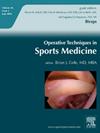Update on Patellofemoral Anatomy and Biomechanics
IF 0.7
4区 医学
Q4 SPORT SCIENCES
引用次数: 0
Abstract
The patellofemoral joint experiences substantial physiologic loads with normal daily activity. Anatomic risk factors can place certain patients at risk for patellofemoral pathology including patellar instability. Stability and load capacity of the joint are a result of numerous factors including the unique configuration of osseous and cartilaginous structures, static and dynamic soft tissue stabilizers, and global lower limb alignment. A thorough understanding of the anatomy and biomechanics of the patellofemoral joint is required to identify patient-specific sources of dysfunction and to tailor individualized treatment specific to a given patient's anatomy. Identification and correction of patient specific risk factors must form the basis for successful treatment strategies. Using novel imaging techniques, dissection methods, and technology for biomechanical evaluation, our understanding of the patellofemoral joint has continued to evolve and in turn can help improve patient specific treatment and outcomes in the management of patellar instability.
髌骨解剖与生物力学最新进展
髌股关节在正常的日常活动中承受着巨大的生理负荷。解剖危险因素可使某些患者有髌股病变的危险,包括髌骨不稳定。关节的稳定性和承载能力是许多因素的结果,包括骨和软骨结构的独特配置,静态和动态软组织稳定剂,以及下肢整体对齐。透彻了解髌股关节的解剖结构和生物力学是确定患者特定的功能障碍来源和针对特定患者解剖结构量身定制个性化治疗的必要条件。识别和纠正患者特定的风险因素必须成为成功治疗策略的基础。利用新的成像技术、解剖方法和生物力学评估技术,我们对髌股关节的理解不断发展,反过来有助于改善患者对髌骨不稳定的特异性治疗和结果。
本文章由计算机程序翻译,如有差异,请以英文原文为准。
求助全文
约1分钟内获得全文
求助全文
来源期刊
CiteScore
0.60
自引率
0.00%
发文量
46
审稿时长
93 days
期刊介绍:
Operative Techniques in Sports Medicine combines the authority of a textbook, the usefulness of a color atlas and the timeliness of a journal. Each issue focuses on a single clinical condition, offering several different management approaches. It''s the easiest way for practitioners to stay informed of the latest surgical advancements and developments.

 求助内容:
求助内容: 应助结果提醒方式:
应助结果提醒方式:


